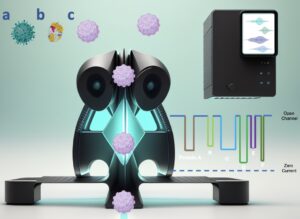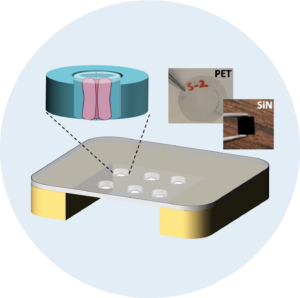Research
Precise Diagnosis
Nanopore Sensor

Nanopores have risen to prominence as cutting-edge single-molecule detectors with enormous potential for advancing protein and nucleic acid analysis in the next generation. By allowing analytes to traverse them individually, nanopores enable the simultaneous quantification of multiple components within a solution mixture, provided they offer sufficient resolution. Our research delves into the design and enhancement of nanopore structures and functionalities, aimed at creating exceptionally sensitive nanopore sensors for biosensing applications across a diverse array of substances.
Source: Talanta, 2021, 223, 121684.
2D Material Sensor

Two-dimensional materials exhibit crucial attributes conducive to the advancement of cutting-edge sensing platforms. These materials boast exceptional qualities, including superior electrical conductivity, impressive surface area-to-volume ratios, outstanding biocompatibility, and a heightened sensitivity to their external surroundings. Leveraging the unique properties of 2D materials, we embark on the development of sensing platforms rooted in resonance energy transfer. This innovative approach allows us to delve into the examination of molecular interactions and the conformational changes of biomolecules, as well as the creation of highly effective biosensors. This pioneering sensing platform holds tremendous promise, particularly in its capacity to enable the simultaneous measurement of multiple biomarkers. One particularly exciting prospect is its potential application in real-time cancer monitoring directly within tumor tissues.
Source: Analyst, 2019, 144, 1825-1830.
Precise Nanostructure and Nanomaterial
Chiral Nanostructure

Chirality manifests at various dimensions within biological entities, influencing their shapes, characteristics, and actions. However, the development of clinical-level applications remains a challenge due to the incomplete comprehension of interactions between chiral molecules and biological surroundings. Our endeavor involves the creation of highly precise chiral nanostructures and the discernment of conformational disparities in adsorbed biological entities. This pursuit aims to enable target-specific biochemistry, molecular sensing, and even the manipulation of organism behavior.
Artificial Nanochannels

Biological ion channels, among Nature’s remarkable creations, efficiently control the movement of ions across cell membranes, displaying characteristics like gating and rectification in ion transport. These properties play a vital role in numerous life processes, including mass transfer, energy conversion, and signal transmission. Our endeavor is to create and engineer artificial nanochannels that mirror the exceptional selectivity of these natural channels. This innovation holds great promise for applications in ion-specific transport, osmotic energy extraction, bioseparation, and biosensing.
Precise Medical
Models and Methods

Early detection of tumor conditions is currently a pinnacle in cancer research, holding immense importance in enhancing the effectiveness of therapeutic interventions. Several variables, including gender, age, tumor type, location, extent, stage, presence of metastases, and inter-sample effects, pose challenges for precise early cancer screening and diagnosis. Our team has developed a cancer biomarker selection model using joint entropy as an assisting tool. We are actively engaged in advancing diagnostic models and analytical techniques to leverage big data and cognitive-capable computers in supporting cancer research experts. This endeavor aims to revolutionize the field of medicine by enabling multifaceted tasks that optimize clinical workflows, bolster diagnostic precision, reduce human resource expenses, enhance data efficiency, and ultimately improve treatment outcomes.